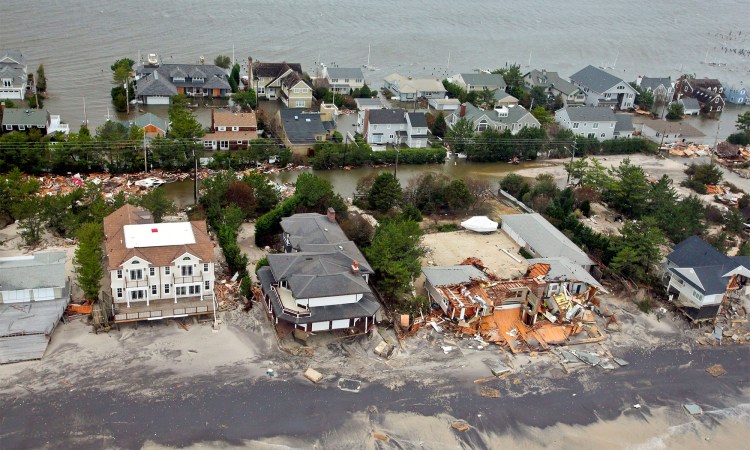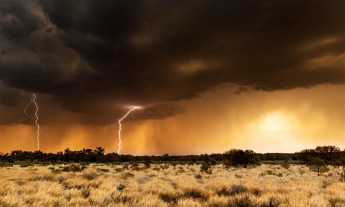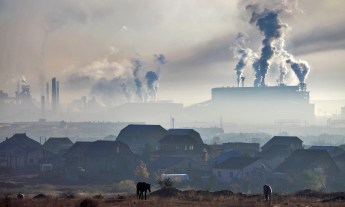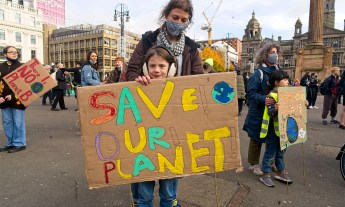
Remember these? Severe heat waves in the US Pacific Northwest and in British Columbia and Siberia.
And this? Historic flooding in Germany and other parts of Western Europe.
These too? Oregon, California, Montana and other parts of the West experiencing searing wildfires.
And this? New York City, Philadelphia, Washington DC and other parts of the Eastern seaboard shrouded in western wildfire smoke.
And keep this in mind: Rising concerns of a “megadrought” across several Western states.
And these are all just from the first half of one year — 2021.
Collectively, they point to a world in the grip of weather extremes fueled by the continuing rise of emissions of human-made — or the technical term, anthropogenic — atmospheric carbon dioxide.
Approaching November 2021, when the 26th United Nations Climate Change Conference of the Parties (COP26) is to convene in Glasgow, Scotland, amid continuing global pandemic concerns, the reality is the number and severity of extreme weather events are overtaking efforts to reduce global greenhouse gas emissions.
There are clear benefits to keeping warming to 1.5°C rather than 2°C or higher. Every bit of warming matters.
“Climate change is moving faster than we are,” U.N. Secretary-General António Guterres said back in 2018 in his address to the UN General Assembly — a statement that in hindsight now rings especially true.
The essential goal of the Paris agreement of 2015 has been to limit the rise in average global temperatures to no more than 2°C above pre-industrial levels — a time period centered roughly on the mid-19th century. The aspirational or wished-for objective of the agreement is to strive for a rise in temperatures that doesn’t exceed 1.5° C (an increase of 1.5°C = about 2.7°F of additional warming; an increase of 2°C = about 3.6°F).
But with carbon dioxide levels in the global atmosphere topping 420 parts per million — the highest level in recorded history — the 1.5°C target appears to many experts to be out of reach. A United Nations report in 2018 concluded as much, saying back then that average global temperatures will likely reach 1.5°C above pre-industrial levels sometime between 2030 and 2052 if emissions continue rising as they have been.
As the planet perhaps inevitably closes in on and goes beyond that 1.5°C target, it’s reasonable to wonder how a world with “just” that degree of warming would compare with a world where global temperatures rise by 2°C or more above preindustrial levels. (Keep in mind that there’s no science suggesting that the warming of the planet’s atmosphere will magically stop at that 2°C limit; indeed, just the opposite).
Still, with a focus solely on those 1.5°C and 2°C global temperature increases, what difference does it make in a practical sense in terms of impacts?
It ends up that the differences are significant.
“There are clear benefits to keeping warming to 1.5°C rather than 2°C or higher. Every bit of warming matters,” Petteri Taalas, of the World Meteorological Organization, and Joyce Msuya, of the United Nations Environment Programme, wrote in the forward of the 2018 report.
The widely publicized “1.5°C Report,” as it’s come to be known, offered a straightforward comparison between the consequences of a 1.5°C future and a 2°C future. Here are highlights (only some of which included a specific “by-this-time” estimate):
About 14% of the world’s population would be exposed to extreme heat waves once every five years if global temperature increases are held to 1.5°C; that percentage jumps to 37% with a rise of 2°C.
Extreme heat
- With a 1.5°C increase, extreme hot days in the mid-latitudes will be 3°C hotter (5.4°F) than pre-industrial levels.
- With a 2°C increase, extreme hot days in the mid-latitudes will be about 4°C hotter (7.2°F) than pre-industrial levels.
A study on extreme heat published around the same time as the UN report projected that about 14 percent of the world’s population would be exposed to extreme heat waves once every five years if global temperature increases are held to 1.5°C. That percentage would jump up to 37 percent with a rise of 2°C. The massive temperature increases seen in British Columbia in the summer of 2021, where temperatures reached an all-time high of 121°F, show clearly that huge spikes in temperature can persist where they are least expected. Numerous areas above the Arctic Circle, including parts of Siberia, also experienced extreme heatwaves in the 2021 summer.
Rising sea levels
- With a 1.5°C increase, sea levels are projected to rise by 2100 by 0.26 to 0.77 meters (0.85-2.52 feet) relative to 1986-2005.
- With a 2°C increase, sea levels are projected to rise by 2100 by 0.36 to 0.87 meters (1.18-2.85 feet) relative to 1986-2005.
One wildcard when it comes to sea-level rise is ice sheet instability in Antarctica and Greenland. An irreversible loss could result in a “multi-meter rise in sea level over hundreds to thousands of years,” according to the 1.5°C report. Greenhouse gas emissions are not the only actor here, however. An 18.6-year cycle in the moon’s orbit around the Earth is projected to make tidal flooding even worse in the mid-2030s.
Declining biodiversity
- With a 1.5°C increase, 6 percent of insects, 8 percent of plants and 4 percent of vertebrates are projected by 2100 to lose more than half of their climatically determined geographic range.
- With a 2°C increase, those percentages double or triple: 18 percent of insects, 16 percent of plants and 8 percent of vertebrates are projected by 2100 to lose more than half of their climatically determined geographic range.
With a 1.5°C rise, about 4 percent of Earth’s terrestrial land area is projected to undergo a transformation of ecosystems from one type to another. With a 2°C global temperature rise, about 13 percent is projected to undergo a shift. Across the American West, ecosystems stressed by diminished snowmelt, drought, insect infestations and wildfire are changing forests from the Rockies to the Sierra Nevada. Ten percent of iconic Giant Sequoia trees died in wildfires in the Sierra Nevada in 2020.
With a 2°C increase, coral reefs are projected to decline by more than 99% — an irreversible loss in many marine and coastal ecosystems.
Melting Arctic sea ice
- With a 1.5°C increase, scientists project that the Arctic Ocean will become ice-free in the summer about once every 100 years.
- With a 2°C increase, the Arctic Ocean could become ice-free in the summer once every 10 years.
An ice-free Arctic can lead to accelerated warming as dark blue sea (as opposed to white ice) absorbs more heat from the sun, through a process known as the albedo effect. Melting sea ice in the Arctic also injects cold water into the Atlantic south of Greenland, upsetting Atlantic Ocean circulation. Scientists reported in 2021 that Atlantic Ocean circulation, which includes the Gulf Stream that brings warm weather to the northeastern US and to Europe, is now at its weakest in more than 1,000 years.
At-risk coral reefs
- With a 1.5°C increase, coral reefs around the world are projected to decline further by 70-90 percent.
- With a 2°C increase, coral reefs are projected to decline by more than 99 percent — an irreversible loss in many marine and coastal ecosystems.
Declining global fisheries
- With a 1.5°C increase, one global model cited by the U.N. report projects a decrease in global annual catch for marine fisheries of about 1.5 million metric tonnes.
- With a 2°C increase, the same model projects a decrease of more than 3 million metric tonnes.
Compared with a rise of 2°C, limiting warming to 1.5°C could reduce the number of people worldwide exposed to climate-related risks and resulting poverty by hundreds of millions fewer people.
Rising poverty
Particular populations around the world are especially vulnerable to the consequences of continued warming. These include some indigenous peoples, local communities dependent on agriculture, and those dependent on coastal resources for their livelihoods. Especially vulnerable places include Arctic ecosystems, dryland regions, small island developing states, and the world’s least developed nations. Compared with a rise of 2°C, limiting warming to 1.5°C could reduce the number of people worldwide who are exposed to climate-related risks and resulting poverty by hundreds of millions fewer people.
Health impacts
With a 2°C increase, compared with a 1.5°C increase, the number of heat-related deaths and the number of people infected with vector-borne diseases such as malaria and dengue fever are projected to increase. A 2°C increase could also potentially lead to shifts in and expansion of the geographic range of vector-borne diseases.
Food impacts
A 2°C increase is projected to lead to increased declines in yields of maize, rice, wheat, and potentially other cereal crops. This outcome is particularly true for sub-Saharan Africa, Southeast Asia and central and South America. Livestock are also projected to be adversely affected.
According to the UN’s 1.5°C report, the world’s countries emitting the largest amounts of carbon dioxide have to turn things around soon.
1.5°C vs. 2°C — a tale of two trajectories
Global greenhouse gas emissions in 2019 totaled 59.1 tons of carbon dioxide equivalent, and while they fell significantly in 2020 as a result of the COVID-19 pandemic, the decline was temporary. The International Energy Agency (IEA) in Paris has projected that emissions will reach a new all-time high in 2023.
The IEA reported that as of the second quarter of 2021, only 2 percent of all government recovery spending in the response to the COVID-19 pandemic (about $380 billion in US dollars) is funding clean energy measures. This amount of money is only about one-third of the amount the IEA says is needed to put the world on track to achieve net zero emissions by 2050.
According to the U.N.’s 1.5°C report, the world’s countries emitting the largest amounts of carbon dioxide have to turn things around soon: To limit warming to 1.5°C, global net greenhouse gas emissions from human activity must decline by about 45 percent from 2010 levels by 2030, and reach net zero by 2050. To limit warming to 2°C, emissions must decline by about 25 percent by 2030 and reach net zero by about 2070.
Despite the great challenge ahead, IEA chief Fatih Birol remarked recently that clean energy investments can still “shift the world on to a pathway to net-zero emissions by 2050.”
The path “is narrow but still achievable,” he said, “if we act now.”
This story originally appeared in Yale Climate Connections.
From 2016 to 2019, the world saw record-breaking heat waves, wildfires and tropical cyclones. Is the increase in extreme weather due to random chance, or changing climate? Watch this TED-Ed lesson to learn more:












